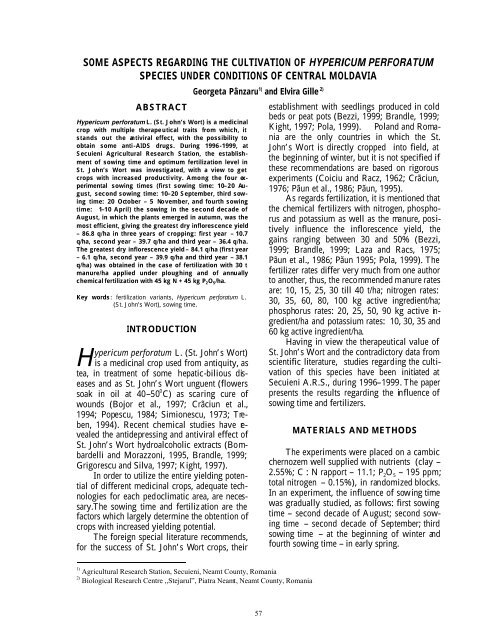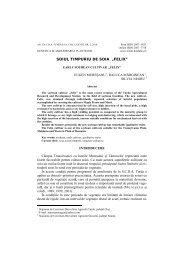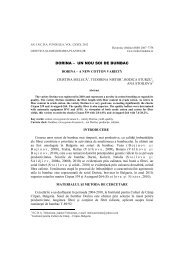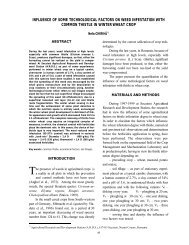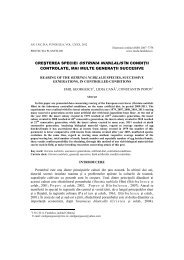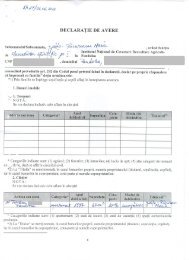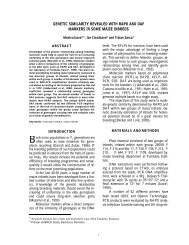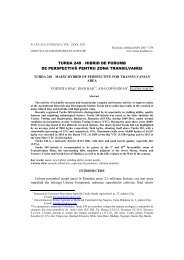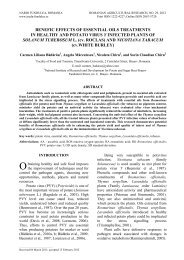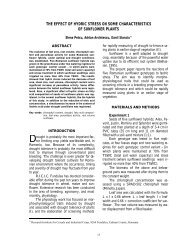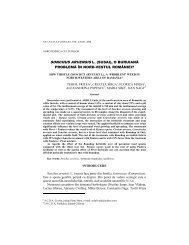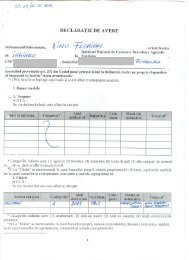some aspects regarding the cultivation of hypericum perforatum ...
some aspects regarding the cultivation of hypericum perforatum ...
some aspects regarding the cultivation of hypericum perforatum ...
You also want an ePaper? Increase the reach of your titles
YUMPU automatically turns print PDFs into web optimized ePapers that Google loves.
SOME ASPECTS REGARDING THE CULTIVATION OF HYPERICUM PERFORATUM<br />
SPECIES UNDER CONDITIONS OF CENTRAL MOLDAVIA<br />
ABSTRACT<br />
Hypericum <strong>perforatum</strong> L. (St. John’s Wort) is a medicinal<br />
crop with multiple <strong>the</strong>rapeutical traits from which, it<br />
stands out <strong>the</strong> antiviral effect, with <strong>the</strong> possibility to<br />
obtain <strong>some</strong> anti-AIDS drugs. During 1996-1999, at<br />
Secuieni Agricultural Research Station, <strong>the</strong> establishment<br />
<strong>of</strong> sowing time and optimum fertilization level in<br />
St. John’s Wort was investigated, with a view to get<br />
crops with increased productivity. Among <strong>the</strong> four experimental<br />
sowing times (first sowing time: 10–20 August,<br />
second sowing time: 10–20 September, third sowing<br />
time: 20 October – 5 November, and fourth sowing<br />
time: 1–10 April) <strong>the</strong> sowing in <strong>the</strong> second decade <strong>of</strong><br />
August, in which <strong>the</strong> plants emerged in autumn, was <strong>the</strong><br />
most efficient, giving <strong>the</strong> greatest dry inflorescence yield<br />
– 86.8 q/ha in three years <strong>of</strong> cropping: first year – 10.7<br />
q/ha, second year – 39.7 q/ha and third year – 36.4 q/ha.<br />
The greatest dry inflorescence yield – 84.1 q/ha (first year<br />
– 6.1 q/ha, second year – 39.9 q/ha and third year – 38.1<br />
q/ha) was obtained in <strong>the</strong> case <strong>of</strong> fertilization with 30 t<br />
manure/ha applied under ploughing and <strong>of</strong> annually<br />
chemical fertilization with 45 kg N + 45 kg P 2 O 5 /ha.<br />
Key words: fertilization variants, Hypericum <strong>perforatum</strong> L.<br />
(St. John’s Wort), sowing time.<br />
H<br />
INTRODUCTION<br />
ypericum <strong>perforatum</strong> L. (St. John’s Wort)<br />
is a medicinal crop used from antiquity, as<br />
tea, in treatment <strong>of</strong> <strong>some</strong> hepatic-bilious diseases<br />
and as St. John’s Wort unguent (flowers<br />
soak in oil at 40–50 0 C) as scaring cure <strong>of</strong><br />
wounds (Bojor et al., 1997; Crãciun et al.,<br />
1994; Popescu, 1984; Simionescu, 1973; Treben,<br />
1994). Recent chemical studies have revealed<br />
<strong>the</strong> antidepressing and antiviral effect <strong>of</strong><br />
St. John’s Wort hydroalcoholic extracts (Bombardelli<br />
and Morazzoni, 1995, Brandle, 1999;<br />
Grigorescu and Silva, 1997; Kight, 1997).<br />
In order to utilize <strong>the</strong> entire yielding potential<br />
<strong>of</strong> different medicinal crops, adequate technologies<br />
for each pedoclimatic area, are necessary.The<br />
sowing time and fertiliz ation are <strong>the</strong><br />
factors which largely determine <strong>the</strong> obtention <strong>of</strong><br />
crops with increased yielding potential.<br />
The foreign special literature recommends,<br />
for <strong>the</strong> success <strong>of</strong> St. John’s Wort crops, <strong>the</strong>ir<br />
Georgeta Pânzaru 1) and Elvira Gille 2)<br />
establishment with seedlings produced in cold<br />
beds or peat pots (Bezzi, 1999; Brandle, 1999;<br />
Kight, 1997; Pola, 1999). Poland and Romania<br />
are <strong>the</strong> only countries in which <strong>the</strong> St.<br />
John’s Wort is directly cropped into field, at<br />
<strong>the</strong> beginning <strong>of</strong> winter, but it is not specified if<br />
<strong>the</strong>se recommendations are based on rigorous<br />
experiments (Coiciu and Racz, 1962; Crãciun,<br />
1976; Pãun et al., 1986; Pãun, 1995).<br />
As regards fertilization, it is mentioned that<br />
<strong>the</strong> chemical fertilizers with nitrogen, phosphorus<br />
and potassium as well as <strong>the</strong> manure, positively<br />
influence <strong>the</strong> inflorescence yield, <strong>the</strong><br />
gains ranging between 30 and 50% (Bezzi,<br />
1999; Brandle, 1999; Laza and Racs, 1975;<br />
Pãun et al., 1986; Pãun 1995; Pola, 1999). The<br />
fertilizer rates differ very much from one author<br />
to ano<strong>the</strong>r, thus, <strong>the</strong> recommended manure rates<br />
are: 10, 15, 25, 30 till 40 t/ha; nitrogen rates:<br />
30, 35, 60, 80, 100 kg active ingredient/ha;<br />
phosphorus rates: 20, 25, 50, 90 kg active ingredient/ha<br />
and potassium rates: 10, 30, 35 and<br />
60 kg active ingredient/ha.<br />
Having in view <strong>the</strong> <strong>the</strong>rapeutical value <strong>of</strong><br />
St. John’s Wort and <strong>the</strong> contradictory data from<br />
scientific literature, studies <strong>regarding</strong> <strong>the</strong> <strong>cultivation</strong><br />
<strong>of</strong> this species have been initiated at<br />
Secuieni A.R.S., during 1996–1999. The paper<br />
presents <strong>the</strong> results <strong>regarding</strong> <strong>the</strong> influence <strong>of</strong><br />
sowing time and fertilizers.<br />
MATERIALS AND METHODS<br />
The experiments were placed on a cambic<br />
chernozem well supplied with nutrients (clay –<br />
2.55%; C : N rapport – 11.1; P 2 O 5 – 195 ppm;<br />
total nitrogen – 0.15%), in randomized blocks.<br />
In an experiment, <strong>the</strong> influence <strong>of</strong> sowing time<br />
was gradually studied, as follows: first sowing<br />
time – second decade <strong>of</strong> August; second sowing<br />
time – second decade <strong>of</strong> September; third<br />
sowing time – at <strong>the</strong> beginning <strong>of</strong> winter and<br />
fourth sowing time – in early spring.<br />
1)<br />
Agricultural Research Station, Secuieni, Neamt County, Romania<br />
2)<br />
Biological Research Centre ,,Stejarul”, Piatra Neamt, Neamt County, Romania<br />
57
58<br />
ROMANIAN AGRICULTURAL RESEARCH<br />
Number 16 / 2001<br />
In ano<strong>the</strong>r experiment, <strong>the</strong> influence <strong>of</strong> fertilizers<br />
was gradually studied, in <strong>the</strong> following<br />
variants: V 1 – unfertilized; V 2 – 45 kg a.i. N/ha<br />
+ 45 kg a.i. P 2 O 5 /ha; V 3 – 90 kg a.i. N + 90 kg<br />
a.i. P 2 O 5 /ha; V 4 – 30 t manure/ha and V 5 – 30 t<br />
manure/ha + 45 kg a.i. N + 45 kg a.i. P 2 O 5 /ha.<br />
The manure was applied under ploughing at <strong>the</strong><br />
establishment <strong>of</strong> <strong>the</strong> crop and <strong>the</strong> chemical fertilizers<br />
were annually applied, as follows: <strong>the</strong><br />
phosphorus fertilizers in autumn and <strong>the</strong> nitrogen<br />
ones in spring, being incorporated by<br />
weedings. It was manually sown, at <strong>the</strong> soil surface,<br />
because <strong>the</strong> St. John’s Wort seeds<br />
require light for germination, with a seed rate <strong>of</strong><br />
4 kg/ha, at 50 cm distance between rows. Before<br />
sowing, <strong>the</strong> field was packed with a roller.<br />
The ,,De Secuieni” population was sown with<br />
seed from <strong>the</strong> previous year yield, because <strong>the</strong><br />
seed postmaturation process has a length <strong>of</strong> one<br />
year. The experiment <strong>regarding</strong> <strong>the</strong> influence <strong>of</strong><br />
fertilization was sown at <strong>the</strong> beginning <strong>of</strong> winter.<br />
The preceding crop was <strong>the</strong> spring two-row<br />
barley. Weedings were performed between and<br />
on rows (two-three), depending on <strong>the</strong> weed<br />
infestation degree and climatic conditions <strong>of</strong> <strong>the</strong><br />
year. The harvesting was manually performed,<br />
by cutting <strong>the</strong> stems on a length <strong>of</strong> 20–25 cm<br />
from <strong>the</strong> peak to <strong>the</strong> base, in <strong>the</strong> stage <strong>of</strong> 30–<br />
50% open flowers. The row material was naturally<br />
dried, under shadow. The hypericine content<br />
was determined only in 1999, at <strong>the</strong> dry<br />
inflorescences, according to spectrophotometric<br />
method, at <strong>the</strong> ,,Stejarul” Biological Research<br />
Center <strong>of</strong> Piatra Neamþ. Data processing was<br />
made by ANOVA test. During <strong>the</strong> research<br />
study, <strong>the</strong> climatic conditions for St. John’s<br />
Wort were favourable. From <strong>the</strong> <strong>the</strong>rmic viewpoint,<br />
<strong>the</strong> years were close to <strong>the</strong> multiannual<br />
average (8.5 0 C), <strong>the</strong> deviations ranging between<br />
-0.3 0 C (1997–1999) and +0.3 0 C (1998–<br />
1999).<br />
As regards <strong>the</strong> rainfall, <strong>the</strong> agricultural year<br />
1996–1997 was <strong>the</strong> most rainy, <strong>the</strong> deviations<br />
vs. multiannual average (545.1 mm) being <strong>of</strong><br />
+ 151.6 mm. In <strong>the</strong> o<strong>the</strong>r two years, <strong>the</strong> deviations<br />
were +10.7 and +37.3 mm, respectively.<br />
RESULTS AND DISCUSSION<br />
The results concerning yield represent <strong>the</strong><br />
average <strong>of</strong> two experiments for each year <strong>of</strong><br />
cropping.<br />
In <strong>the</strong> first year, only one cutting was obtained<br />
and <strong>the</strong> sowing time significantly influenced<br />
<strong>the</strong> dry inflorescence yield (Table 1). The<br />
greatest yield (10.7 kg dry inflorescence/ha)<br />
was obtained in <strong>the</strong> first sowing time, in <strong>the</strong><br />
second decade <strong>of</strong> August, <strong>the</strong> gain vs. control<br />
(third sowing time – at <strong>the</strong> beginning <strong>of</strong> win ter)<br />
being <strong>of</strong> 4.8 q/ha (81%). At this sowing time,<br />
<strong>the</strong> plants emerged from autumn and entered<br />
into <strong>the</strong> winter in two leaflet stage. The plant<br />
density at emergence was <strong>of</strong> 10.5 pl./m 2 . In <strong>the</strong><br />
second sowing time – <strong>the</strong> second decade <strong>of</strong><br />
September and control – sown at <strong>the</strong> beginning<br />
<strong>of</strong> winter, <strong>the</strong> yields obtained were <strong>of</strong> 6.3 and<br />
5.9 q dry inflorescence/ha, respectively.<br />
Table 1. Influence <strong>of</strong> sowing time on dry inflorescence yield at Hypericum <strong>perforatum</strong> L.,<br />
first year <strong>of</strong> cropping one cutting (1996–1997)<br />
Variants<br />
First sowing time:<br />
10–10 August<br />
Second sowing time:<br />
10–20 September<br />
Third sowing time (winter):<br />
20 October – 5 November<br />
Fourth sowing time (early spring):<br />
1–10 April<br />
Drying output = 4.22<br />
Dry inflorescence yield<br />
q/ha % diff. signif.<br />
Density at<br />
emergence<br />
pl./m 2<br />
Plant height<br />
at harvesting<br />
cm<br />
10.7 181 4.8 *** 10.5 45.2<br />
Date <strong>of</strong><br />
emergence<br />
1–10<br />
September<br />
6.3 106 0.4 - 9.2 38.2 1–10 May<br />
5.9 100 control - 8.9 37.9 1–10 May<br />
- - - - 8.6 20.0<br />
LSD 5% = 0.85 q/ha;<br />
1% = 1.22 q/ha ;<br />
0.1% = 1.80 q/ha.<br />
30 May –<br />
10 June
GEORGETA PÂNZARU AND ELVIRA GILLE. : SOME ASPECTS REGARDING THE CULTIVATION<br />
OF HYPERICUM PERFORATUM SPECIES UNDER CONDITIONS OF CENTRAL MOLDAVIA<br />
59<br />
At <strong>the</strong>se two sowing times, <strong>the</strong> plants<br />
emerged in <strong>the</strong> spring (1–10 May), <strong>the</strong> density<br />
<strong>of</strong> emergence being about 9 pl./m 2 at both sowing<br />
times (8.9–9.2). In <strong>the</strong> first year <strong>of</strong> cropping,<br />
<strong>the</strong> fourth sowing time – in <strong>the</strong> spring (1–<br />
10 April), <strong>the</strong> plants emerged during 30 May–<br />
30 June and did not reach <strong>the</strong> technical maturity.<br />
In <strong>the</strong> second year <strong>of</strong> cropping, two cuttings<br />
were obtained and <strong>the</strong> highest increase <strong>of</strong><br />
dry inflorescence yield (39.7 q/ha) was registered<br />
at <strong>the</strong> first sowing time – <strong>the</strong> second decade<br />
<strong>of</strong> August, <strong>the</strong> gain vs. control – <strong>the</strong> third<br />
sowing time, at <strong>the</strong> beginning <strong>of</strong> winter – being<br />
<strong>of</strong> 1.9 q/ha (5%) ( Table 2).<br />
The control and <strong>the</strong> o<strong>the</strong>r sowing times<br />
(<strong>the</strong> second sowing time – <strong>the</strong> second decade <strong>of</strong><br />
September and <strong>the</strong> fourth sowing time – in<br />
spring) registered considerably equal yields,<br />
between 37.4 and 37.8 q/ha.<br />
In <strong>the</strong> third year <strong>of</strong> cropping, two cuttings/year<br />
were obtained (Table 3). The dry inflorescence<br />
yields obtained in <strong>the</strong> fourth studied<br />
sowing times were practically equal and varied<br />
between 36.2 and 36.7 q/ha.<br />
The hypericine content was <strong>the</strong> same at all<br />
<strong>the</strong> sowing times, 0.1%, which confirms <strong>the</strong><br />
data from <strong>the</strong> special literature which mention<br />
that <strong>the</strong> hypericine accumulation in St. John’s<br />
Wort is, firstly, genetically controlled and followed<br />
by <strong>the</strong> environmental conditions and applied<br />
technology (Brandle, 1999).<br />
In <strong>the</strong> fourth year <strong>of</strong> cropping, <strong>the</strong> plants<br />
regenerated only in percentage <strong>of</strong> 10%, which<br />
did not justify <strong>the</strong> experiments maintenance,<br />
both for <strong>the</strong> sowing time and <strong>the</strong> influence <strong>of</strong><br />
Table 2 . Influence <strong>of</strong> sowing time on dry inflorescence yield at Hypericum <strong>perforatum</strong> L.,<br />
second year <strong>of</strong> cropping, two cuttings (1997–1998)<br />
Variants<br />
First sowing time:<br />
10–10 August<br />
Second sowing time:<br />
10–20 September<br />
Third sowing time (winter):<br />
20 October – 5 November<br />
Fourth sowing time (early spring):<br />
1–10 April<br />
Drying output = 4.22 first cutting<br />
Yield<br />
I II<br />
Dry inflorescence yield, q/ha<br />
I + II % diff. signif.<br />
Plant height<br />
cm<br />
27.8 11.9 39.7 105 1.9 * 95.9<br />
27.4 10.3 37.7 99 -0.1 97.7<br />
26.4 11.4 37.8 100 control 94.8<br />
27.2 10.2 37.4 98 -0.4 95.1<br />
LSD 5% = 1.39 q/ha;<br />
3.75 second cutting 1% = 2.00 q/ha;<br />
0.1% = 2.95 q/ha.<br />
Table 3. Influence <strong>of</strong> sowing time on dry inflorescence yield at Hypericum <strong>perforatum</strong> L.,<br />
third year <strong>of</strong> cropping, two cuttings (1998–1999)<br />
Variants<br />
First sowing time:<br />
10–10 August<br />
Second sowing time:<br />
10–20 September<br />
Third sowing time (winter):<br />
20 October – 5 November<br />
Fourth sowing time (early spring):<br />
1–10 April<br />
Drying output = 3.77 first cutting<br />
Dry inflorescence yield, q/ha<br />
Yield<br />
I + II % diff. signif.<br />
I II<br />
Hypericine<br />
content<br />
%<br />
Plant<br />
height<br />
cm<br />
26.2 10.2 36.4 100 0.2 0.1 106.2<br />
26.4 10.3 36.7 101 0.5 0.1 105.9<br />
26.0 10.2 36.2 100 control 0.1 106.0<br />
26.1 10.1 36.2 100 0.0 0.1 106.3<br />
LSD 5% = 0.79 q/ha;<br />
3.89 second cutting 1% = 1.14 q/ha;<br />
0.1% = 1.68 q/ha.
60<br />
ROMANIAN AGRICULTURAL RESEARCH<br />
Number 16 / 2001<br />
fertilizers.<br />
From <strong>the</strong> total <strong>of</strong> yields during <strong>the</strong> three<br />
years <strong>of</strong> cropping (Table 4), <strong>the</strong> greatest yield<br />
(86.8 q dry inflorescences/ha) was achieved at<br />
<strong>the</strong> first sowing time – <strong>the</strong> second decade <strong>of</strong><br />
August, <strong>the</strong> gain vs. control – <strong>the</strong> third sowing<br />
time at <strong>the</strong> beginning <strong>of</strong> winter – being <strong>of</strong> 6.9<br />
q/ha (9%).<br />
The St. John’s Wort dry inflorescence<br />
yield was significantly influenced by <strong>the</strong> applied<br />
fertilizers, too.<br />
In <strong>the</strong> first year <strong>of</strong> cropping, one cutting<br />
only was obtained (Table 5). In comparison<br />
with <strong>the</strong> unfertilized control, <strong>the</strong> fertilizers applied<br />
in rates <strong>of</strong> 45 kg N + 45 kg P 2 O 5 /ha and<br />
90 kg N + 90 kg P 2 O 5 /ha, determined <strong>the</strong><br />
achievement <strong>of</strong> <strong>some</strong> statistically ensured yield<br />
gains by 0.6 q/ha (14%) and 0.8 q/ha (19%),<br />
respectively. A dry inflorescence gain <strong>of</strong> 1.4<br />
q/ha (32%) vs. <strong>the</strong> unfertilized control, was obtained<br />
by <strong>the</strong> application <strong>of</strong> 30 t manure/ha.<br />
The greatest dry inflorescence yield (6.1<br />
q/ha) was obtained in <strong>the</strong> variant fertilized with<br />
30 t manure + 45 kg N + 45 kg P 2 O 5 /ha, <strong>the</strong><br />
gain vs. control being <strong>of</strong> 1.8 q/ha (42%).<br />
In <strong>the</strong> second year <strong>of</strong> cropping, two cuttings<br />
were obtained and <strong>the</strong> greatest dry inflorescence<br />
yield (39.9%) was achieved in <strong>the</strong><br />
variant fertilized with 30 t manure + 45 kg N +<br />
45 kg P 2 O 5 /ha, <strong>the</strong> gain vs. unfertilized control<br />
being <strong>of</strong> 14.6 q/ha (58%) (Table 6). The influence<br />
<strong>of</strong> manure applied in <strong>the</strong> first year was<br />
benefic for <strong>the</strong> second year too, <strong>the</strong> yield obtained<br />
in <strong>the</strong> variant fertilized with 30 t manure/ha<br />
being 37.9 q/ha and <strong>the</strong> gain vs. unfertilized<br />
control, 12.6 q/ha (50%). In <strong>the</strong> variants<br />
fertilized with chemicals, yield gains were also<br />
achieved vs. unfertilized control, by 3.6 q/ha<br />
(14%) in <strong>the</strong> variant fertilized with 45 kg N +<br />
45 kg P 2 O 5 /ha and by 11.4% in <strong>the</strong> variant fertilized<br />
with 90 kg N + 90 kg P 2 O 5 /ha.<br />
Table 4 . Influence <strong>of</strong> sowing time on dry inflorescence yield at Hypericum <strong>perforatum</strong> L.,<br />
yield sum <strong>of</strong> first, second and third years <strong>of</strong> cropping (1996–1999)<br />
Variants<br />
Dry inflorescence yield<br />
q/ha % diff. signif.<br />
First sowing time: 10–10 August 86.8 109 6.9 ***<br />
Second sowing time: 10–20 September 80.7 101 0.8<br />
Third sowing time (winter): 20 Oct. – 5 Nov. 79.9 100 control<br />
Fourth sowing time (early spring): 1–10 April 73.6 92 -6.3 °°<br />
LSD 5% = 3.03 q/ha;<br />
1% = 4.36 q/ha;<br />
0.1% = 6.43 q/ha.<br />
Table 5 . Influence <strong>of</strong> fertilizers on dry inflorescence yield at Hypericum <strong>perforatum</strong> L.,<br />
first year <strong>of</strong> cropping one cutting (1996–1997)<br />
Variants<br />
Dry inflorescence yield<br />
q/ha % diff. signif.<br />
Plant height at<br />
harvesting<br />
Unfertilized 4.3 100 control 28.4<br />
45 kg N + 45 kg P 2 O 5 /ha 4.9 114 0.6 * 34.2<br />
90 kg N + 90 kg P 2<br />
O 5<br />
/ha 5.1 119 0.8 ** 38.1<br />
30 t manure/ha 5.7 132 1.4 *** 37.9<br />
30 t manure + 45 kg N + 45 kg P 2<br />
O 5<br />
/ha 6.1 142 1.8 *** 38.4<br />
Drying output = 4.09<br />
LSD 5% = 0.42 q/ha;<br />
1% = 0.59 q/ha;<br />
0.1% = 0.83 q/ha.<br />
cm
GEORGETA PÂNZARU AND ELVIRA GILLE. : SOME ASPECTS REGARDING THE CULTIVATION<br />
OF HYPERICUM PERFORATUM SPECIES UNDER CONDITIONS OF CENTRAL MOLDAVIA<br />
61<br />
Table 6. Influence <strong>of</strong> fertilizers on dry inflorescence yield at Hypericum <strong>perforatum</strong> L.,<br />
second year <strong>of</strong> crop, two cutting (1997–1998)<br />
Dry inflorescence yield, q/ha<br />
Plant<br />
Variants<br />
Yeild<br />
height<br />
I + II % diff. signif.<br />
I II<br />
cm<br />
Unfertilized 17.7 7.6 25.3 100 control *** 81.7<br />
45 kg N + 45 kg P 2 O 5 /ha 20.3 8.6 28.9 114 3.6 *** 92.3<br />
90 kg N + 90 kg P 2 O 5 /ha 26.4 10.3 36.7 145 11.4 *** 95.2<br />
30 t manure/ha 27.1 10.8 27.9 150 12.6 *** 95.0<br />
30 t manure + 45 kg N + 45 kg P 2<br />
O 5<br />
/ha 28.2 11.7 39.9 158 14.6 *** 95.3<br />
Drying output = 3.68 first cutting LSD 5% = 1.19 q/ha;<br />
3.81 second cutting 1% = 1.67 q/ha;<br />
0.1% = 2.36 q/ha.<br />
In <strong>the</strong> third year <strong>of</strong> cropping, two cuttings<br />
were also obtained (Table 7). The greatest dry<br />
inflorescence yield (38.1 q/ha) was obtained in<br />
<strong>the</strong> variant fertilized with 30 t manure + 45 kg<br />
N + 45 kg P 2 O 5 /ha, <strong>the</strong> gain vs. unfertilized<br />
control being <strong>of</strong> 13.8 q/ha (57%). The variant<br />
fertilized with 90 kg N + 90 kg P 2 O 5 /ha followed<br />
with an yield <strong>of</strong> 36 q/ha, <strong>the</strong> gain vs. unfertilized<br />
control being <strong>of</strong> 11.7 q/ha (48%).<br />
The hypericine content was not significantly<br />
influenced by fertilizers, being almost <strong>the</strong><br />
same in all variants (0.099% – unfertilized and<br />
0.1% – <strong>the</strong> o<strong>the</strong>r variants).<br />
From <strong>the</strong> total sum <strong>of</strong> yield during <strong>the</strong><br />
three years <strong>of</strong> cropping (Table 8), <strong>the</strong> greatest<br />
yield (84.1 q dry inflorescence/ha) was<br />
achieved in <strong>the</strong> variant fertilized with 30 t manure<br />
+ 45 kg N + 45 kg P 2 O 5 /ha, <strong>the</strong> gain vs.<br />
unfertilized control being <strong>of</strong> 30.2 q/ha (56%). In<br />
<strong>the</strong> variants fertilized with 30 t manure/ha, at<br />
<strong>the</strong> establishment <strong>of</strong> <strong>the</strong> crop, and 90 kg N + 90<br />
kg P 2 O 5 /ha, annually applied, equal yields were<br />
achieved (77.9–77.8 q/ha), <strong>the</strong> gains vs. unfertilized<br />
control, being <strong>of</strong> 24 and 23.9 q/ha<br />
(44%), respectively.<br />
Table 7. Influence <strong>of</strong> fertilizers on dry inflorescence yield at Hypericum <strong>perforatum</strong> L.,<br />
third year <strong>of</strong> cropping, two cuttings (1997–1998)<br />
Variants<br />
Dry inflorescence yield, q/ha<br />
Hypericine Plant<br />
Yield<br />
I + II % diff. signif.<br />
content height<br />
I II<br />
% cm<br />
Unfertilized 18.0 6.3 24.3 100 control 0.099 86.9<br />
45 kg N + 45 kg P 2<br />
O 5<br />
/ha 19.7 8.2 27.9 115 3.6 *** 0.1 99.2<br />
90 kg N + 90 kg P 2<br />
O 5<br />
/ha 26.1 9.9 36.0 148 11.7 *** 0.1 105.3<br />
30 t manure/ha 24.1 10.2 34.3 141 10.0 *** 0.1 106.1<br />
30 t manure + 45 kg N + 45 kg P 2<br />
O 5<br />
/ha 26.7 11.4 38.1 157 13.8 *** 0.1 105.7<br />
Drying output = 3.82 first cutting<br />
LSD 5% = 1.31 q/ha;<br />
3.96 second cutting 1% = 1.85 q/ha;<br />
0.1% = 2.61 q/ha.<br />
Table 8. Influence <strong>of</strong> fertilizers on dry inflorescence yield at Hypericum <strong>perforatum</strong> L.,<br />
yield sum <strong>of</strong> first, second and third year <strong>of</strong> cropping (1996–1999)<br />
Variants<br />
Dry inflorescence yield<br />
q/ha % diff. signif.<br />
Unfertilized 53.9 100 control<br />
45 kg N + 45 kg P 2 O 5 /ha 61.7 114 7.8 ***<br />
90 kg N + 90 kg P 2 O 5 /ha 77.8 144 23.9 ***<br />
Manure 30 t/ha 77.9 144 24.0 ***<br />
30 t manure + 45 kg N + 45 kg P 2<br />
O 5<br />
/ha 84.1 156 30.2 ***<br />
LSD 5% = 2.92 q/ha;<br />
1% = 4.11 q/ha;<br />
0.1% = 5.80 q/ha.
62<br />
ROMANIAN AGRICULTURAL RESEARCH<br />
Number 16 / 2001<br />
CONCLUSIONS<br />
Dry inflorescence yield <strong>of</strong> St. John’s Wort<br />
(Hypericum <strong>perforatum</strong> L.) was influenced by<br />
<strong>the</strong> sowing time. The optimum sowing time is<br />
<strong>the</strong> second decade <strong>of</strong> August, when <strong>the</strong> seeds<br />
found optimum conditions for germination,<br />
which favourized <strong>the</strong> plant emergence in autumn.<br />
During <strong>the</strong> three years <strong>of</strong> cropping, <strong>the</strong><br />
greatest yield was obtained – 86.8 q/ha (first<br />
year – 10.7 q/ha; second year – 39.7 q/ha and<br />
third year – 36.4 q/ha), <strong>the</strong> gain vs. <strong>the</strong> control –<br />
sown at <strong>the</strong> beginning <strong>of</strong> winter, being <strong>of</strong> 6.9<br />
q/ha (9%).<br />
The manure applied at <strong>the</strong> establishment <strong>of</strong><br />
<strong>the</strong> crop and nitrogen and phosphorous fertilizers,<br />
annually applied, had a positively influence<br />
on dry inflorescence yield, under <strong>the</strong> conditions<br />
<strong>of</strong> Secuieni A.R.S.<br />
The greatest inflorescence yield – 84.1<br />
q/ha, <strong>the</strong> sum <strong>of</strong> yields obtained during <strong>the</strong><br />
three years <strong>of</strong> cropping (first year – 6.1 q/ha;<br />
second year – 39.9 q/ha and third year – 38.1<br />
q/ha) was registered in <strong>the</strong> variant fertilized<br />
with 30 t manure + 45 kg N + 45 kg P 2 O 5 /ha,<br />
<strong>the</strong> gain vs. <strong>the</strong> unfertilized control being <strong>of</strong><br />
30.2 q/ha (56%).<br />
The hypericine content, determined only in<br />
1999, was not significantly influenced by both<br />
sowing time and fertilization variants, ranging<br />
between 0.099 and 0.1%.<br />
REFERENCES<br />
Bezzi, A., 1999. Produzione delle piantine da trapianto. Italia.<br />
Bojor, O., Alexan, M.et al., 1997. Plantele medicinale ºi aromatice<br />
de la A la Z. Edit. Ulpia Traiana, Bucureºti.<br />
Bombardelli, E., Morazzoni, P., 1995. Hypericum <strong>perforatum</strong> .<br />
Fitoterapia, vol. LXVI, no 1, Milan, Italy: 43–68.<br />
Brandle, J., 1999. St. John’s Wort – Hypericum <strong>perforatum</strong> .<br />
Agriculture and Agri-Food, Canada.<br />
Coiciu, Ev., Racz, G., 1962. Plantele medicinale ºi aromatice.<br />
Edit. Acad.R.P.Române, Bucureºti: 341–344.<br />
Crãciun, F. et al., 1976. Farmacia naturii. Edit. Ceres, Bucureºti,<br />
vol.I: 176–179.<br />
Crãciun, F. et al., 1994. Ghidul plantelor medicinale uzuale.<br />
Bucureºti: 116–117.<br />
Grigorescu, E., Silva, F., 1997. De la etnomedicinã la fitoterapie.<br />
Edit. Spiru Haret, Iaºi: 114, 426, 521.<br />
Kight, J., 1997. St. John’s Wort Herbs for Health. Canada.<br />
Laza, E., Racz, G., 1975. Plante medicinale ºi aromatice. Edit.<br />
Ceres, Bucureºti: 155–156.<br />
Pãun, E. et al., 1986. Tratat de plante medicinale ºi aromatice<br />
cultivate. Edit. Acad. R.S.România, vol I: 318–325.<br />
Pãun, E., 1995. Sãnãtatea Carpaþilor. Edit. F&D Stil Commerce,<br />
Bucureºti: 103–104.<br />
Pola, J.F., 1999. Cultivo de plantas medicinales – Hypericum<br />
<strong>perforatum</strong> . Portugalia.<br />
Popescu, N., 1984. Resurse medicinale în flora României.<br />
Edit. Dacia, Cluj-Napoca: 114–115.<br />
Simionescu, I., 1973. Flora României. Ediþia a IV-a. Edit. Alb a-<br />
tros, Bucureºti: 138.<br />
Treben, M., 1994. Sãnãtatea din farmacia Domnului. Budapesta:<br />
57–59.
GEORGETA PÂNZARU AND ELVIRA GILLE. : SOME ASPECTS REGARDING THE CULTIVATION<br />
OF HYPERICUM PERFORATUM SPECIES UNDER CONDITIONS OF CENTRAL MOLDAVIA<br />
63<br />
Table 1. Influence <strong>of</strong> aluminum ions, in reaction mixture, on <strong>the</strong> level <strong>of</strong> saccharasic<br />
activity in a reddish-brown soil fertilized with compost with different quantities (glucose+fructose-mg/100<br />
g soil dw/24 hours)<br />
b 3287 100 b 4028 100 b 2579 100 b 3472 100 b 3341 100<br />
A- Factor B – Factor – COMPOST (t/ha) Average (A)<br />
b1-0 % b2-0 % b3-0 % b4-0 % %<br />
a1–without<br />
Al 3+<br />
a2- with Al 3+ a 4228 129 a 5019 125 a 3472 135 a 4528 130 a 4312 129<br />
Average (B) 3757 c 4523 a 3025 d 4000 b<br />
LD P 5% 1% 0,1%<br />
A 291 673* 2143<br />
B 101 142 201*<br />
AB 302 628* 1799<br />
BA 144* 201 284<br />
Table 2. Influence <strong>of</strong> aluminum ions, in reaction mixture, on <strong>the</strong> level <strong>of</strong> saccharasic<br />
activity in a chernozem mineral fertilized or manured with farmyard compost (glucose+fructose-mg/100<br />
g soil dw/24 hours)<br />
A- Factor B – Factor – COMPOST (t/ha) Average (A)<br />
b1-0 % b2-N 32 P 32 % b3-N 94 P 96 % b4- % b5 compost<br />
% %<br />
N 128 P 128<br />
a1–without Al 3+ b 1564 100 b 1496 100 b 1459 100 b 1401 100 b 1732 100 b 1530 100<br />
a2- with Al 3+ a 1686 108 a 1581 106 a 1684 115 a 1589 113 a 1864 108 a 1681 110<br />
Average (B) 1625 b 1538 d 1571 c 1495 e 1798 a<br />
LD P 5% 1% 0,1%<br />
A 7 17 54*<br />
B 14 20 27*<br />
AB 19 28 45*<br />
BA 20* 28 39


